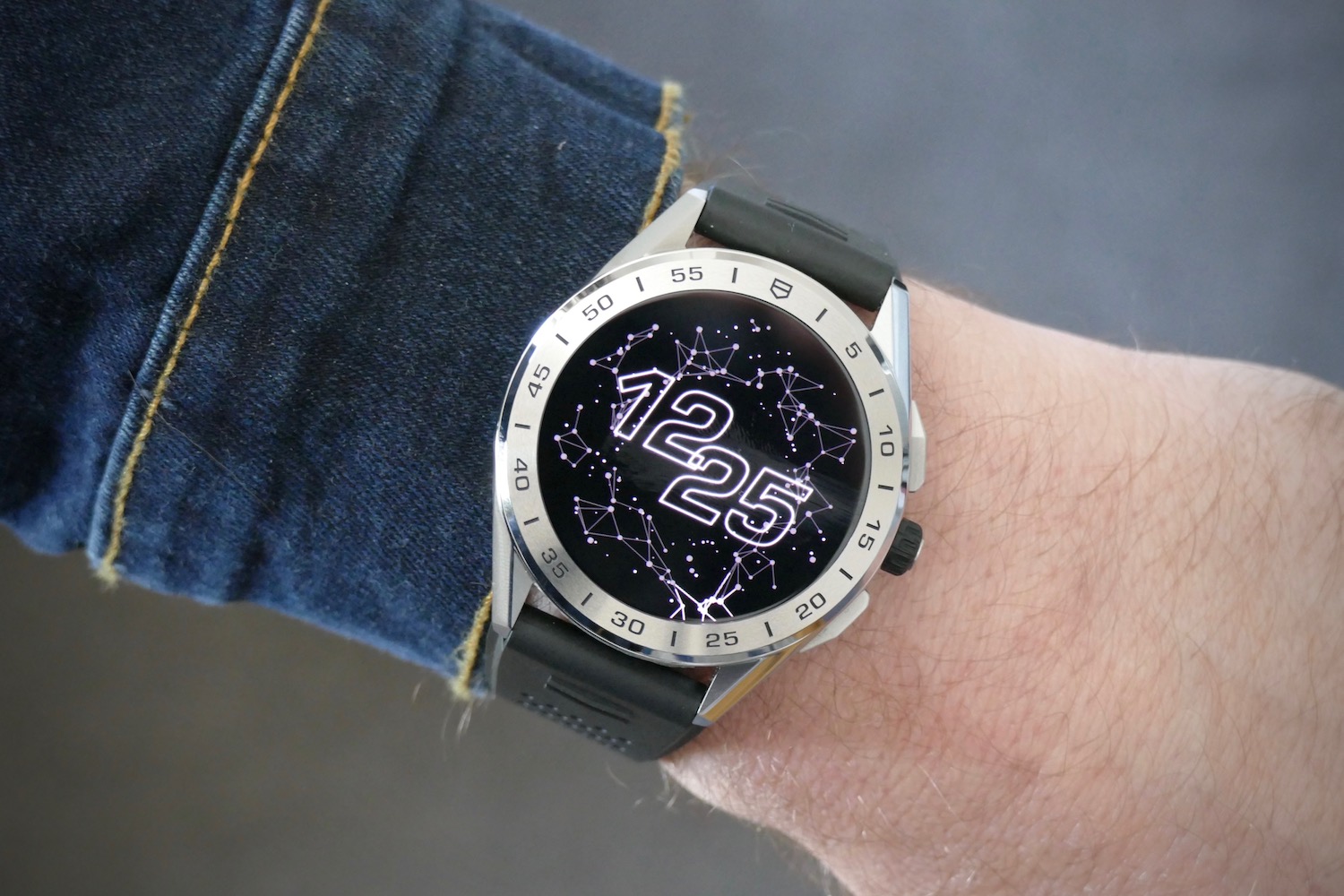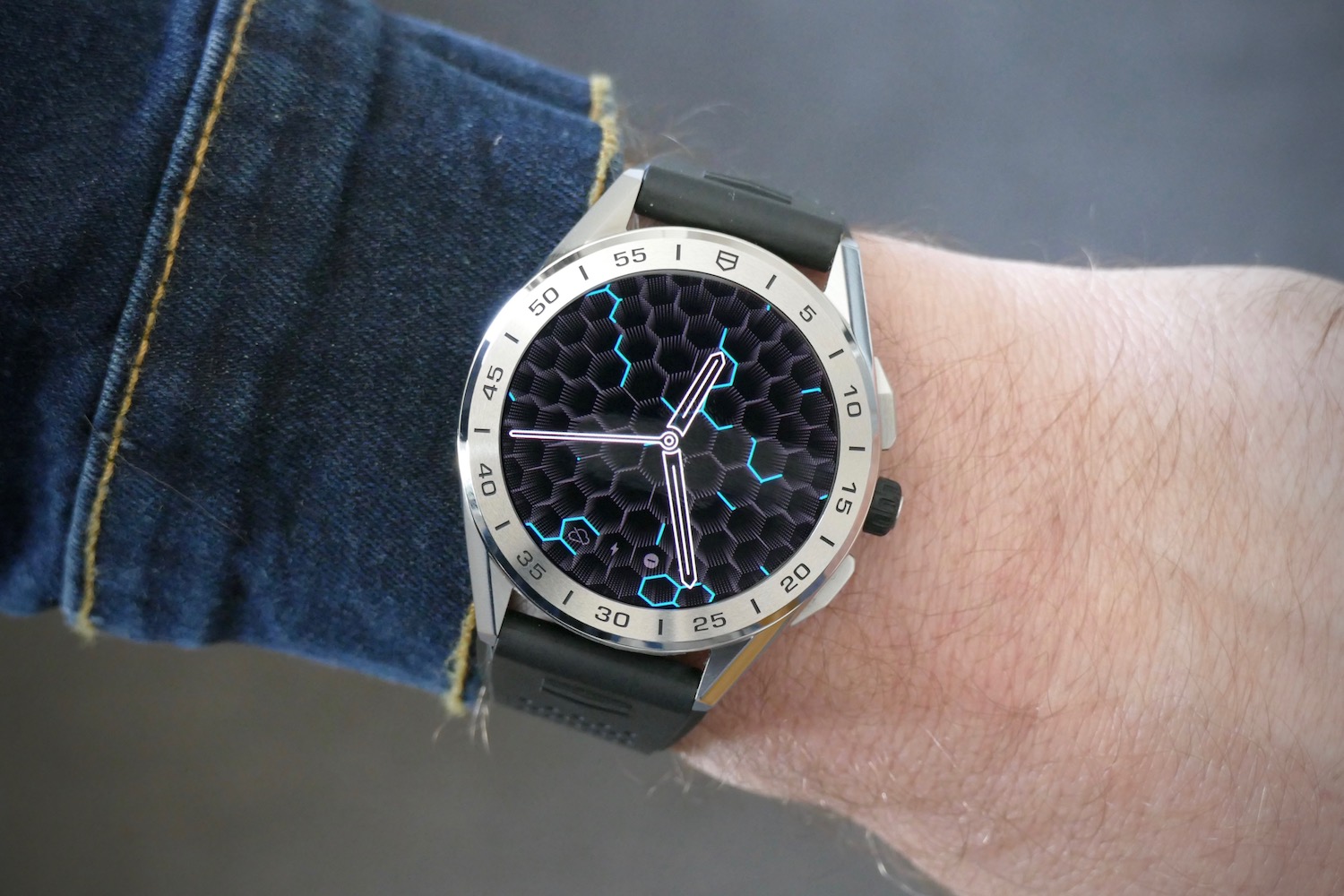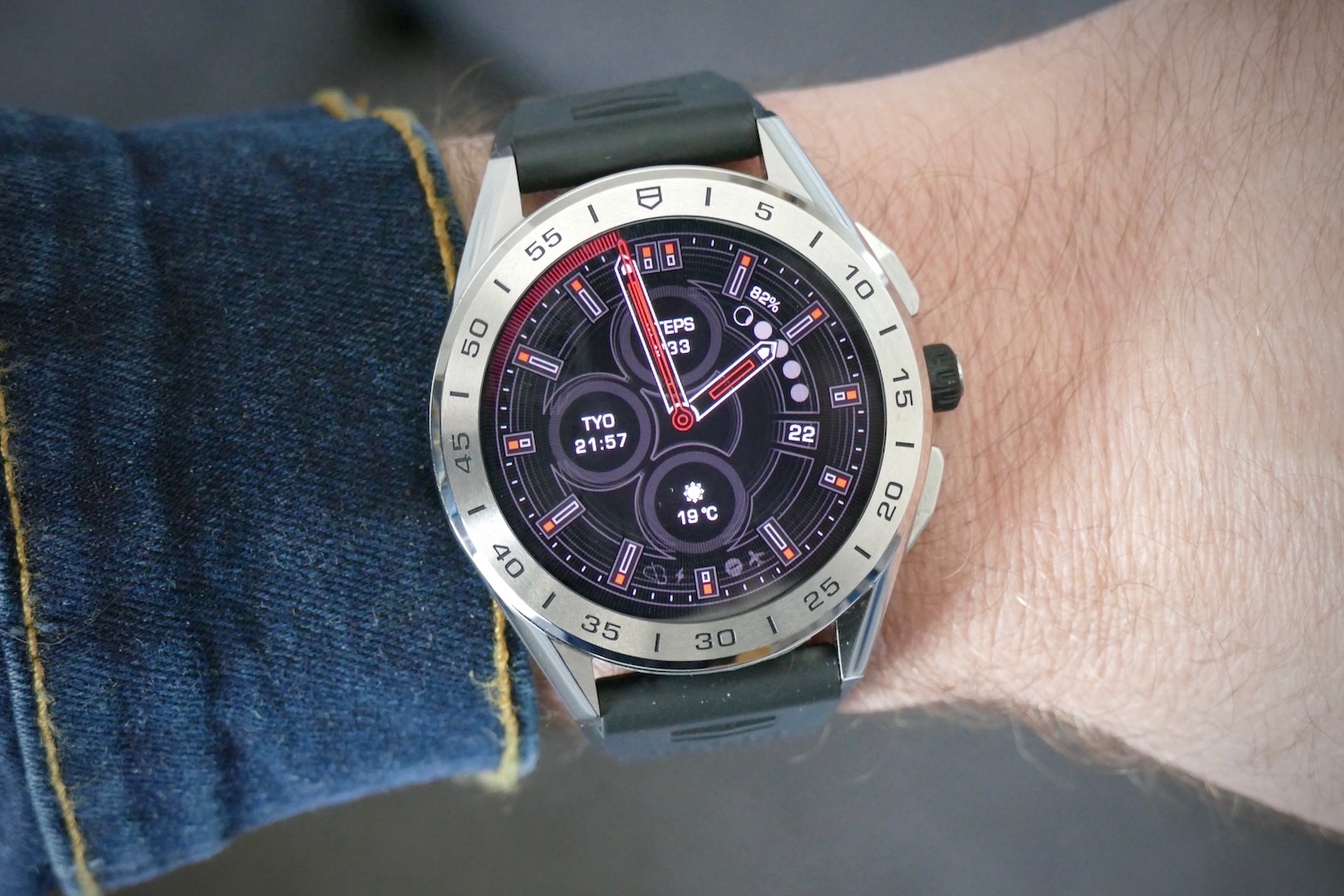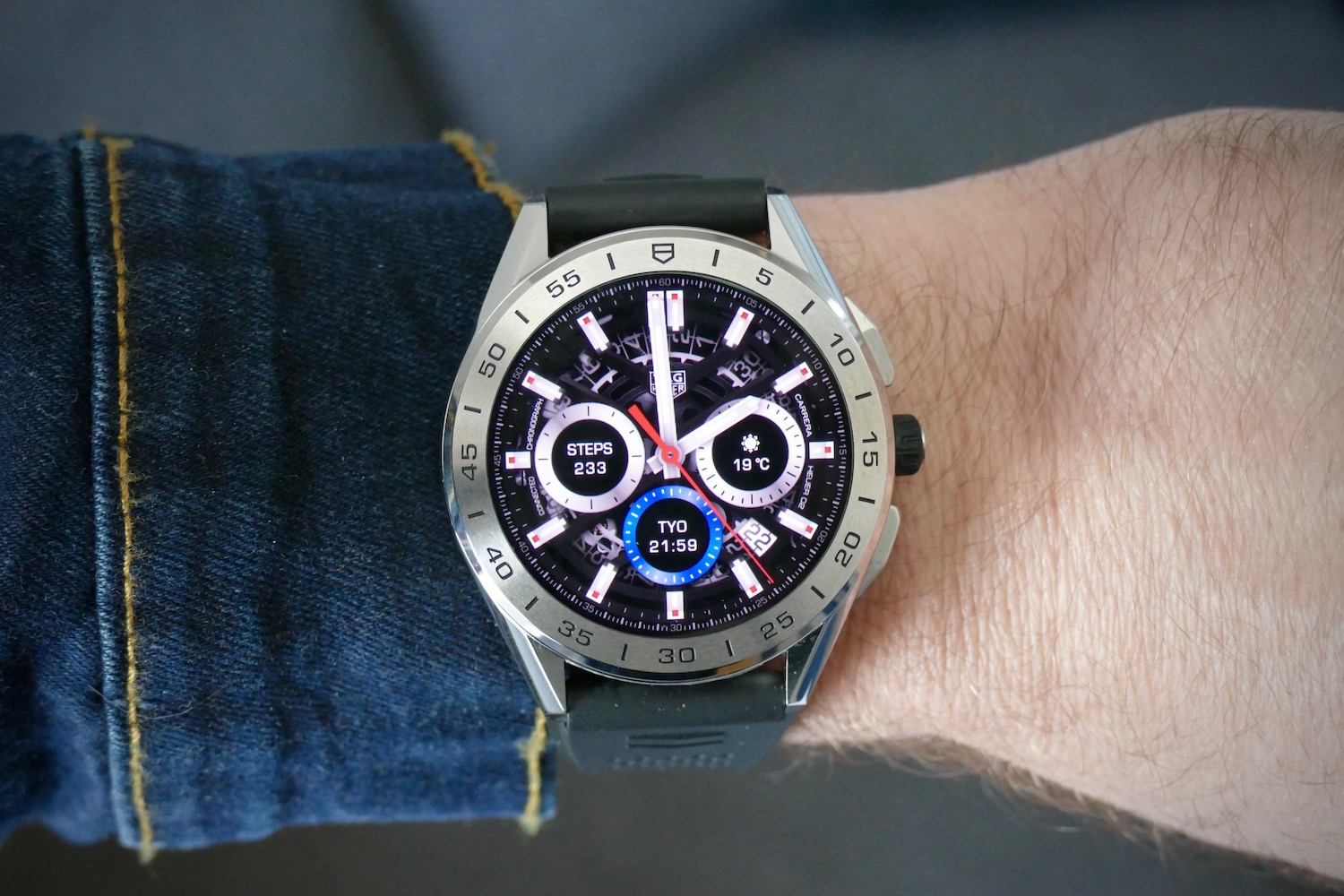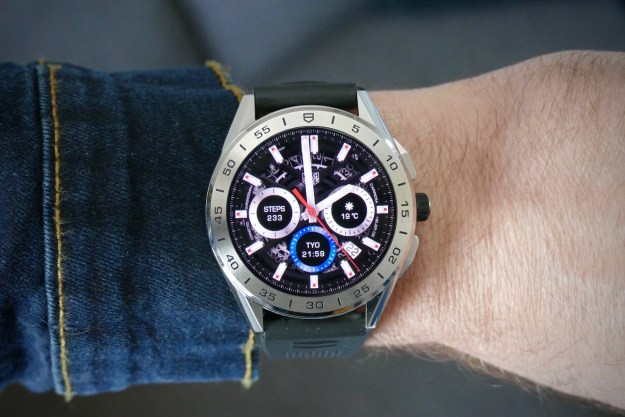
“The Tag Heuer Connected is a desirable smartwatch that's easy to love at first sight.”
- Beautiful design and comfortable to wear
- Sapphire crystal over the screen
- Good battery life
- Heart rate sensor and custom fitness app
- Expensive, obviously
- No ability to make or receive calls
Is there any difference to putting on and wearing a Tag Heuer smartwatch over any other WearOS smartwatch? The answer is yes — but it has nothing to do with the tech. The Tag Heuer Connected gives us a Swiss smartwatch that’s not just for brand-loyal watch geeks, but for everyone with a chunk of disposable income to spend on something special.
Design
It’s oh so pretty. So, so pretty. The Tag Heuer Connected you see here has a stainless steel case, a fixed ceramic bezel in brushed steel, plus a rubber strap. It’s understated yet classy, stylistically goes with everything, and still obviously a Tag Heuer. You can buy versions with metal straps, and with a matte black Physical Vapor Deposition (PVD) coating. I was a little concerned about the size of the new version before seeing it in real life, as it’s a sizable 44mm wide and 13.5mm thick case, but my worry wasn’t needed.

It’s just right. That’s thanks to the minimal bezel around the lovely screen, the sleek buttons, and the sensibly sized horns. Sapphire crystal covers the screen, and it blends directly into the bezel. This is important for ergonomics, as it makes the touchscreen more comfortable to use. There’s no bezel on the screen itself, with the display taking up the whole of the watch face.
The sapphire is wonderful to look at with its signature sheen, and it provides scratch protection. The hefty metal buttons — new for a Tag Heuer Connected smartwatch — have a positive action. The strap is thick yet soft, strong but pliable, and I adore the chamfered edge of the bezel which gives just the right amount of bling in sunlight. The rubber coating on the crown is a great move, as it increases grip when using it to scroll through the menu system.

However, the watch is quite thick, something visually compensated for by clever tapering around the heart rate sensor. That doesn’t stop it being a pain to fit under tightly fitting shirt sleeves. The heart rate sensor extends out of the body to ensure good contact with your wrist, increases the watch’s profile when worn.
It’s not a heavy watch, at least, and the rubber strap remains comfortable. I happily wore the smartwatch all day without it becoming uncomfortable. It feels close to a traditional high-end luxury watch.
Tag Heuer has abandoned modularity, meaning none of the major components are interchangeable, including the horns. It has accepted this is a smartwatch and therefore needs to be suitable for everyone, not an add-on purchase picked up by its established clientele alongside a $6,350 Tag Heuer Monaco Gulf. This gives the watch more focus and makes it nicer to own, not just by those who want the cache that comes with the name, but also those who want a luxury smartwatch to wear and use each day.
Software
The last WearOS watch I wore for any length of time was the Suunto 7, and the software experience was better than many others. I’m pleased to say the Tag Heuer is similarly improved over older (and cheaper) WearOS watches. General use, such as notifications, using Google Assistant, and fitness tracking, is stutter-free and speedy, making the watch pleasant to use on a daily basis. When you use online services like the Play Store there is some lag, but it’s not something I used regularly enough to notice.
Tag Heuer’s watch face collection is pleasingly varied, but oddly limited. There are two classic Tag Heuer faces which look great, but I’d have like to see more options, rather than abstract faces. These graphic-heavy faces, called Carbon and Orbital, do look fantastic, especially the way the moving stars on the Orbital face represent the second hand; but they don’t exactly say Tag Heuer, which is likely important to anyone buying this watch.
The initial WearOS setup process is slow and cumbersome, with inputting of passwords, agreeing to different agreements, and installing updates. It takes up to 45 minutes, much of which requires the watch to be on its charger. Compare this to the faster, less tedious setup required by an Apple Watch, and the introduction to your Tag Heuer watch is less than ideal.
However, this is a problem with the software, rather than this watch, and happens no matter the WearOS model you buy. Even after this, you still need to install some essential apps, including Google Maps and Google Fit, which don’t come standard yet greatly enhance the ownership experience.

There are several pre-installed Tag Heuer apps. The excellent Golf app, which was previously seen on the Golf Edition Tag Heuer watch, now uses the buttons on the case for faster navigation is on the watch. It needs the Tag Heuer Golf app on your phone, and I noticed the course list is still out of date. It shows my local course as open, but it’s been closed for many years. Outside of this, the app is a great companion on the golf course.
There’s also a beautifully designed custom timer and stopwatch app, plus a new Sports app. It provides settings for golf, running, cycling, walking, fitness, and a general fitness tracking mode. Like the golf app, the physical buttons are active to make stopping and pausing easy, and the display shows time, calories, and heart rate data.
The app still needs polishing, however. For example, the rotating crown does not work when inputting your personal data, but does elsewhere in the app. Otherwise, it’s well designed, and syncs with the Tag Heuer Sports app on your phone quickly. The data isn’t comprehensive and is clearly made for casual fitness fans only.

Google Fit is available, but again, the crown does not work with the software. Out of the box, the hardware buttons are configured to activate Tag Heuer’s apps but can be changed to those of your choice. I like Google Assistant’s helpful screen which is swiped from the left, which shows weather, appointments, and other Assistant features like delivery data in a clear and concise fashion.
Notifications can be replied to using canned responses or with a tiny keyboard. The former is preferable. I received fewer repeated notifications than I have with some other WearOS smartwatches, but instead found some notifications were not delivered at all. Again, notification inconsistency is a problem with WearOS, rather than this particular smartwatch. WearOS works well here, but even then it doesn’t come close to the robust reliability of Apple’s WatchOS.
Screen, connectivity, and performance
The 1.4-inch OLED screen has 454 x 454-pixel resolution, so you see information clearly. The lack of a bezel gives it an ultra-modern style, especially when reading text. Detail is pin-sharp, colors are striking, and sunlight visibility is good, something helped out by a decent auto-brightness feature. It adapted to both indoor and outdoor lighting conditions quickly, and stuck with its choice rather than randomly increasing or decreasing the level like some other WearOS watches. The always-on screen is a further success, showing the time, complete with animated second hand, at a glance without needing to raise your wrist and without any noticeable impact on battery life.

This comes in part from the Qualcomm Snapdragon Wear 3100 platform, which powers the watch. It’s a massive improvement over the old Snapdragon Wear 2100 platform, and the benefits around efficiency and speed are obvious. There’s almost no stuttering, and even connecting to the Google Play Store — often a pain point in terms of speed — is acceptable. Google Assistant is easy to use with your voice, activated after a long press of the crown, and it answers the same kind of questions you’d ask your phone without a problem. I still wouldn’t use it in public, though.
You can’t make or receive calls from the Tag Heuer Connected. When a call comes through the watch alerts you, but answering switches it instantly to your phone. While speaking to your watch presents the same social acceptance problem as talking to Google Assistant, it’s a handy feature sometimes, and considering the price of the Tag Heuer Connected, it’s a shame it’s not included. Vibration is subtle but strong enough to be felt.

It’s also the first Tag Heuer smartwatch to come with a heart rate sensor. Comparing it to the Apple Watch Series 5, it consistently read two or three beats faster. I trust the Apple Watch for several reasons, but mostly its consistency of showing my resting heart rate as the same over many months, while others deviate more.
Battery
Compared to the watch itself, the included charging plinth is rather downmarket and made of plastic. It magnetically attaches to the back of the watch and takes coming up to one hour, 30 minutes to fully charge. This feels very slow going now we have smartphones with significantly larger batteries charging in an hour or less.
The 430mAh battery has easily lasted for a full day with moderate use and about 45 minutes of exercise tracked using Google Fit, or Tag Heuer’s own app. Restrictions on movement have made it impossible to test the impact of using wider fitness features beyond this. Without fitness tracking and only notifications, the Tag Heuer Connected has lasted for a day and a half. Not bad at all.
Price, availability, and warranty
The Tag Heuer Connected is not expensive by luxury watch standards but is expensive by smartwatch standards. The steel case/black rubber strap model seen here is $1,800 or 1,495 British pounds, but you could pay at least $2,350 or 1,950 pounds for the titanium versions. The collection is available through Tag Heuer’s own online store now. Tag Heuer provides a two-year warranty, but this does not cover the battery or the crystal.
Our take
With the new Tag Heuer Connected, Tag Heuer has fully committed itself to making a true smartwatch. Forgetting the modular features has resulted in a better made, more focused, and more wearable smartwatch than any version before it. While it doesn’t boast additional features over many other WearOS smartwatches, the design, construction, and materials eclipse everything else out there, ensuring it provides the requisite luxury desirability expected from a Tag Heuer. WearOS doesn’t frustrate and performs well too, and all this elevates it above the ownership experience delivered by many sub-$300 smartwatches.
Is there a better alternative?
There are two ways to look at this question. If you are looking for an alternative luxury smartwatch your options are few. The $995 Montblanc Summit 2 Plus is a similarly compact, beautifully stylish WearOS smartwatch. Apple’s $1,400 Apple Watch Series 5 Hermés edition is also very special, mostly because of the gorgeous straps and unique watch faces. Then there is the $795 Movado Connect 2.0, and even the Alpina AlpinerX, which stands out because it doesn’t use WearOS.
If you want a smartwatch and don’t really care if it’s from a luxury brand, there are many more options. We like the $295 Fossil Gen 5, the $280 Samsung Galaxy Watch Active 2, and the fantastic $275 Diesel On Fadelite.
These are all WearOS watches which work with Android and iOS phones, but if you own an iPhone there is only one smartwatch you should be buying — the $400 Apple Watch Series 5.
What’s important to point out here is that whether you buy a luxury smartwatch or not, the features across all WearOS watches are broadly identical. By selecting a luxury model you are paying more for the materials, the build quality, and the brand name more than any additional features.
How long will it last?
A smartwatch should last about two to three years, and that is applicable to any smartwatch, luxury or otherwise. This is due to the degradation of the battery, advances in technology, and availability of software updates. The Tag Heuer Connected itself is water-resistant to 50 meters, has a stainless steel body, sapphire crystal, and a ceramic bezel, meaning it’s very hard-wearing.
Tag Heuer has also dropped modularity, so you can’t swap out the smartwatch body for a mechanical body, thereby keeping your straps and horn options, when the digital part is past its best. The costs in doing this were high, but did perhaps add some value to Tag Heuer collectors, and help justify the initial price.
Should you buy it?
Yes, but just know what you’re buying. You’re buying a Tag Heuer smartwatch, and you have to accept the enormous additional cost and what it means compared to spending around $300 on another smartwatch.
